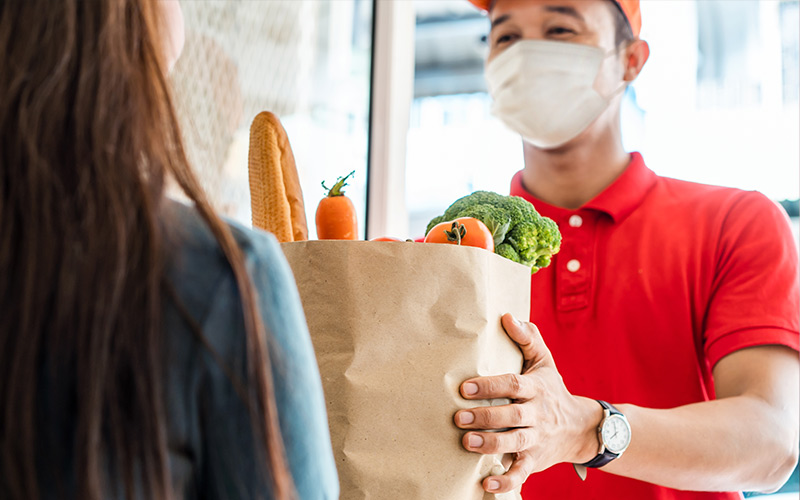The grocery industry is at a crossroads—either adapt and stay afloat or remain stationary and hope for the best. Changing consumer trends and expectations have made the traditional grocery retail model incapable of sustaining a successful business. And the pandemic has only sped up the rate of change across the sector.
For starters, online grocery shopping is booming with sales reaching a record $7.2 billion this past June, and a recent Blue Yonder survey found that one-third of consumers have used an online grocery delivery service to purchase their groceries during the COVID-19 pandemic.
With technology continuing to develop and be implemented more widely, tedious processes like manual inventory tracking will become obsolete, and warehouses and micro-fulfillment centers will soon be as important as brick-and-mortar locations. Streamlining and optimizing inventory will be the key to profitability, but where do grocers even begin when it comes to executing all of this?
The circular supply chain is designed with the customer at the forefront of all supply chain processes, and each of those processes is connected to enable a seamless, end-to-end operation. Artificial intelligence (AI) and machine learning (ML) technologies are crucial for supply chain strategies to become more agile and move from read-and-react to predict-and-pivot.
To keep up with this transformation and take grocery into the future, here are three ways to enable a circular supply chain with AI and ML and ensure success in grocery retail:
Gain Visibility into Data
Grocery retailers have access to an abundant amount of data—from raw sales figures to consumer’s food shopping behaviors and preferences—and should use it across the entire supply chain to ensure informed operational decisions at every step. However, that data must be easily accessible and understandable. Accessible and understandable data enables retailers to continually re-evaluate the right inventory, assortment, price, and more based on a myriad of external factors, including holidays, the weather, social media sentiment, and more. This level of visibility allows for profit-driven strategies to be executed across the supply chain.
AI and ML technologies can collect, sort, and analyze data autonomously, doing away with tedious manual processes and dated spreadsheets, resulting in better business decisions. For instance, instead of choosing to discount the price of a popular granola bar brand based on antiquated statistical techniques for historical sales, AI and ML can produce precise recommendations based on thousands of data points, creating a more accurate—and more profitable—operation overall. In the case of the granola bar, the historical sales data may have told the grocery store to discount the product based on outdated data for the 2019 back-to-school season. This may not be an accurate prediction in 2020, as COVID-19 has shifted many schools’ schedules back or into online learning environments.
The technology can ultimately show the user why and how those recommendations are made, allowing for true visibility into every facet of the process. AI and ML models are not a black box, but made of glass, allowing for better understandability, decisions and outcomes.
Optimize Inventory
Grocers work on razor-thin margins, so as inventory moves from aggregated demand and safety stock to customer preferences and business strategy, they must focus on cost-optimization.
Grocery retailers that implement AI and ML in their supply chains will uncover ideal inventory levels for every single SKU in their stores. For instance, if a store carries 20 different flavors of yogurt, AI and ML can tell the retailer exactly how much of each flavor it should keep in stock to maximize profitability. Using accurate algorithms that look at everything from the time of year to what’s trending on social media, the technology may recommend increasing stock of pumpkin spice in October while discontinuing or lowering stock of a more tropical-inspired flavor.
Strategically positioning inventory is another way grocery retailers are reducing their costs, especially with the increase in online grocery delivery and pickup options. Micro-fulfillment centers are popping up everywhere to get customers their items quickly and efficiently. These centers are known for being hyperlocal, both in terms of the personalized inventory they offer as well as proximity to where shoppers live, and they dramatically reduce last-mile delivery costs by keeping inventory closer to the end destination.
Ensure Planning Synchronization and Agility
Today’s grocery planning must be dynamic and agile to support a supply chain that balances local and global sources, while also keeping the online customer in mind. The latest data, trends and consumer needs must be acknowledged and understood in real-time to give customers what they want—when they want it.
For example, paper towels and toilet paper were hot grocery sellers at the beginning of the pandemic. Most grocers weren’t prepared for a sudden onslaught of paper product panic-buying, so out-of-stocks on these items became widespread both online and in stores. Dynamic planning processes can help detect such issues as soon as they begin and proactively trigger actions that will enable grocers to mitigate risk and avoid out-of-stocks. AI and ML can help to respond to challenges in an automated but visible manner, allowing teams to deliver more effectively.
Rapid, unanticipated changes in consumer shopping trends have led to an increased need for state-of-the-art supply chain technology within the grocery space, and these supply chains must be seamless and agile to keep up with such uncertain times. A customer-driven circular supply chain powered by AI and ML can ensure the longevity of any grocery retailer—no matter what might happen next.
For more information on Blue Yonder’s solutions for grocery retailers, visit blueyonder.com.

